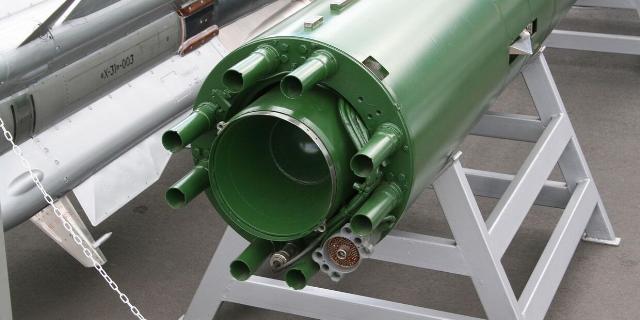TNI: the Soviet torpedo "Shkval" revolutionized underwater warfare
The Soviet-era torpedo “Squall” revolutionized underwater warfare, writes TNI. Thanks to the rocket engine and the phenomenon of supercavitation, she could reach an unprecedented speed of up to 200 knots. Meanwhile, in the United States, such weapons have not reached serial production.
Kyle Mizokami
During the Cold War, the Soviet Union focused on the submarine fleet in order to negate America's naval advantage. The U.S. Navy's task was not just to stop the transfer of reinforcements to Europe in the event of World War III, but also to threaten the Soviet Union directly by tracking down and sinking its ballistic missile submarines. At the same time, the USSR, in order to even the odds, used a huge number of diesel-electric submarines, and eventually switched to more advanced nuclear attack.
One of the most advanced Soviet-designed underwater weapons was the VA-111 Shkval supercavitation torpedo. The weapon was developed in the strictest secrecy and became known to the public only in the mid-1990s. Equipped with a rocket engine, the torpedo developed a fantastic speed of up to 200 knots per hour. How, in a world where physics itself limits the maximum speed of most ships and underwater weapons to 50 knots, did Russian engineers manage to achieve such a breakthrough in speed?
Traditionally, propellers or water cannons are used in torpedoes for propulsion. The Shkval is equipped with a rocket engine. This alone is enough to give it speed, but moving in the water creates serious resistance problems. Solution: remove water from the path of the torpedo.
But how can this be achieved in the middle of the ocean? Solution: turn liquid water into gas.
The Squall solved this problem by diverting hot exhausts from the bow so that they turned the water in front of the torpedo into steam. As the torpedo moves forward, it continues to evaporate water, creating a thin bubble of gas. Moving through the gas, the torpedo experiences much less resistance, which allows it to reach speeds of up to 200 knots. This process is called supercavitation.
The cost of supercavitation is to prevent the torpedo from escaping from the gas bubble. This complicates maneuvers and turns, because when changing course, at least part of the torpedo breaks out of the bubble, causing sharp resistance at a speed of 370 kilometers per hour. Early versions of the Squall, apparently, had only an extremely primitive guidance system, and the attack was carried out mainly in a straight line.
Given that the warhead could have been nuclear, this would certainly have been enough to destroy the target. And the Soviet Union at that time quite reasonably put the speed of torpedoes above maneuverability.
The Shkval began to be developed back in the 1960s as a means of rapid attack on NATO nuclear missile submarines - in order to deliver nuclear warheads at a speed never seen before. The torpedo has a standard diameter of 533 millimeters and carries a warhead weighing 210 kilograms. The maximum firing range is 6,900 meters. Serial production began in 1978, and in the same year the Shkval entered service with the Soviet Navy.
But, like any weapon, the “Squall" has its drawbacks. Firstly, the resulting gas bubble and the torpedo's rocket engine are very noisy. Any submarine instantly gives out its approximate location by launching a supercavitating torpedo. At the same time, such a fast-moving weapon may well destroy the enemy before he has time to react to the information received: after all, in addition to the actual enemy submarine, he will also have to deal with a torpedo at a speed of 200 knots.
Another disadvantage of the supercavitation torpedo is the inability to use traditional guidance systems. The gas bubble and rocket engine produce so much noise that they jam the built-in active and passive sonar guidance systems. Early versions of the “Squall”, apparently, were completely out of control — the designers refused to maneuver for the sake of speed. The more modern version uses a compromise approach: the torpedo uses supercavitation to get close to the target, and then slows down for precise guidance.
Is there a future for supercavitation torpedoes? The United States has been working on such weapons since 1997, but it has not reached mass production. As a result, the US Navy is currently upgrading the Mark 48 torpedo of a very venerable age for use in the foreseeable future. On the other hand, the requirements of the US Navy were initially much higher than the capabilities of the “Squall” — including the military requesting the possibility of turning, target identification and guidance.
Meanwhile, Russian submarines are still the only ones in the world equipped with supercavitation torpedoes - upgraded versions of the Shkval with conventional warheads. The Russian industry also offers the export model “Shkval E" abroad. Iran claims that it has its own supercavitation torpedo called “Hut” — presumably, it is a redesigned “Squall".
In 2004, the German defense contractor Diehl-BGT announced a demonstration torpedo "Barracuda", capable of speeds up to 194 knots. The Barracuda was designed to be launched from submarines and surface ships, and the test models could move along straight and curved trajectories. However, apparently, the program has not been crowned with a finished product.
The noisy but effective “Squall” destroys the usual paradigm of underwater warfare. A 200—knot torpedo is an extremely attractive tool, and as competition intensifies in both the Atlantic and Pacific Oceans, it is possible that more and more naval forces around the world will begin to arm themselves with supercavitating technologies and adjust tactics accordingly. As a result, the underwater war will become much louder and more deadly.
Kyle Mizokami is a San Francisco—based defense and national security journalist who has published in The Diplomat, Foreign Policy, War is Boring and The Daily Beast. In 2009, he co-founded the defense and security blog Japan Security Watch

